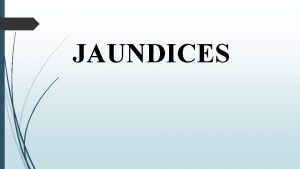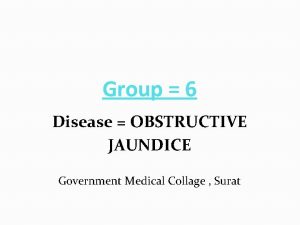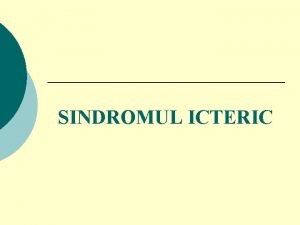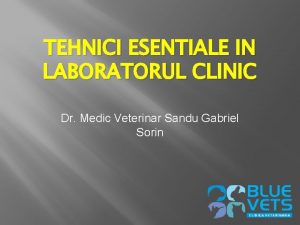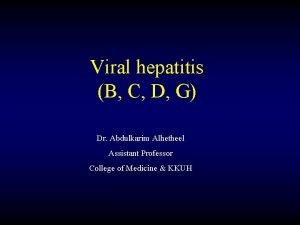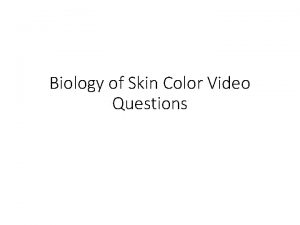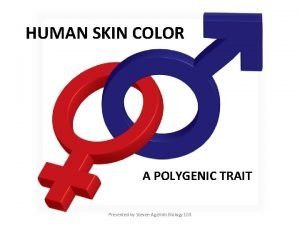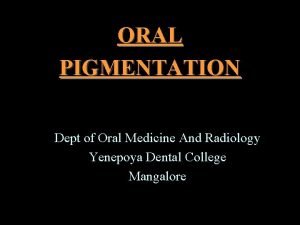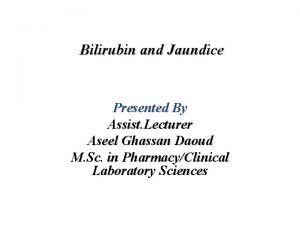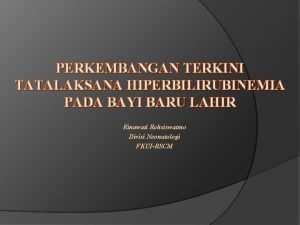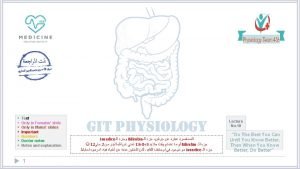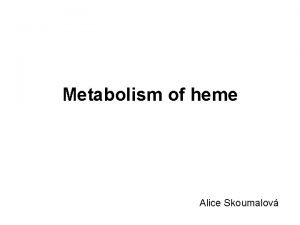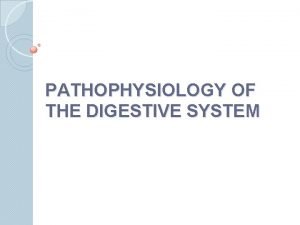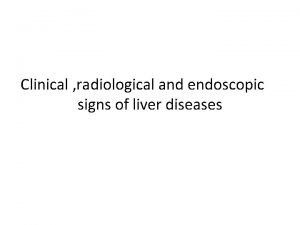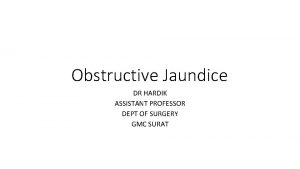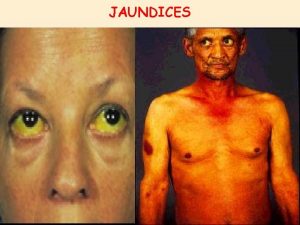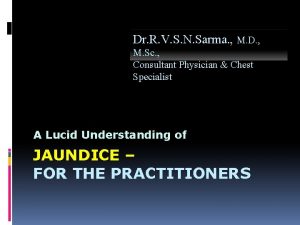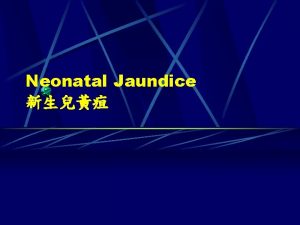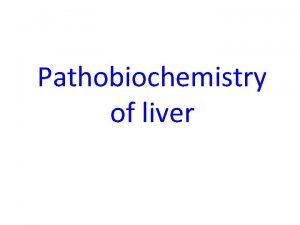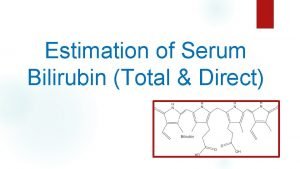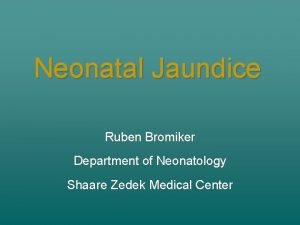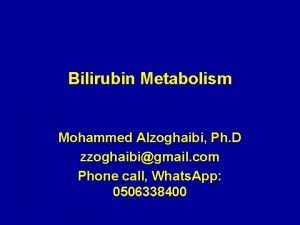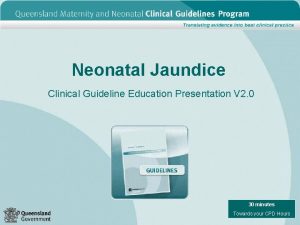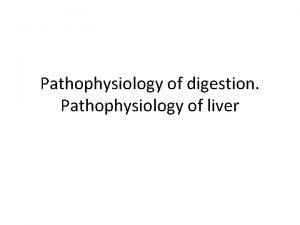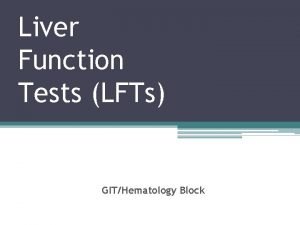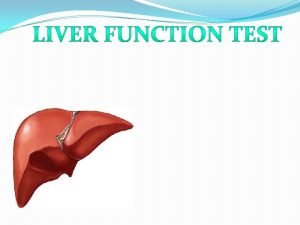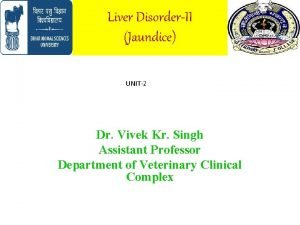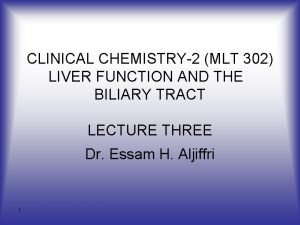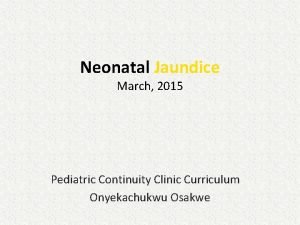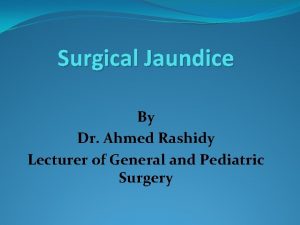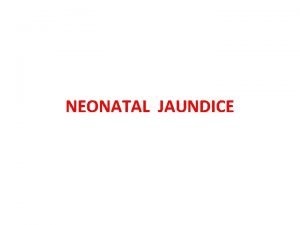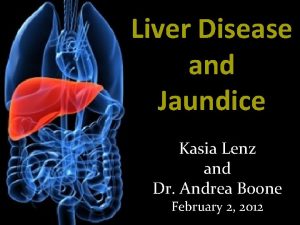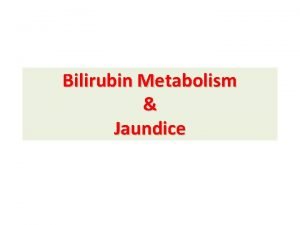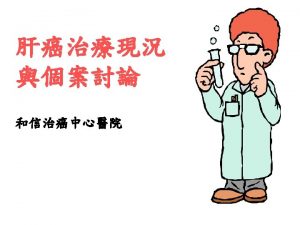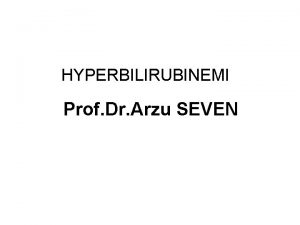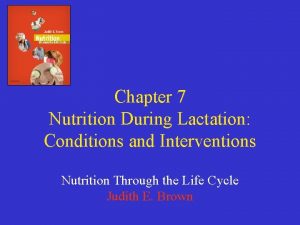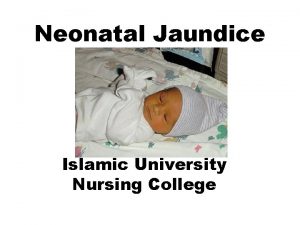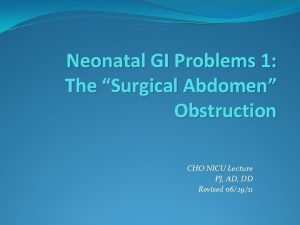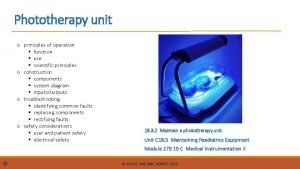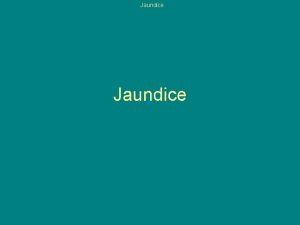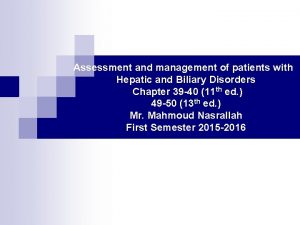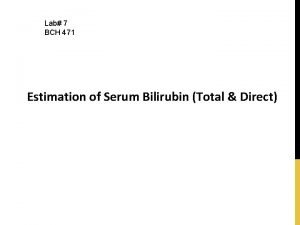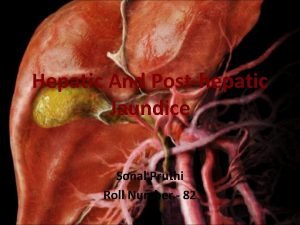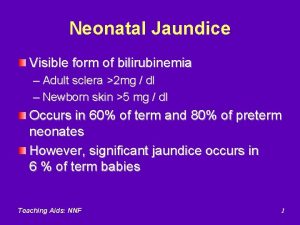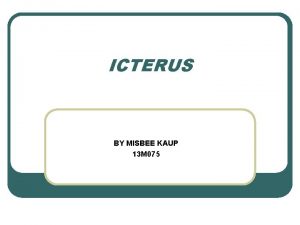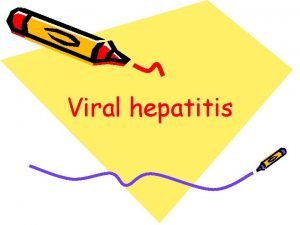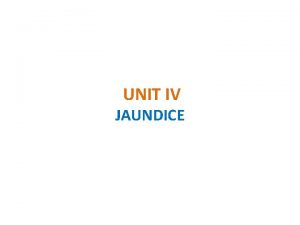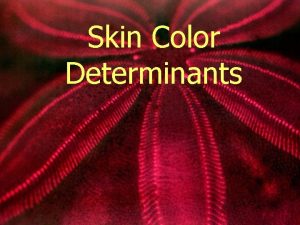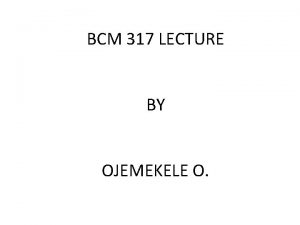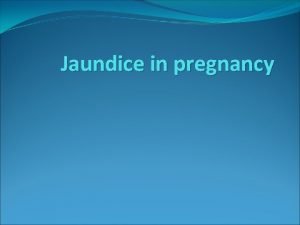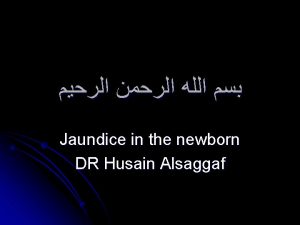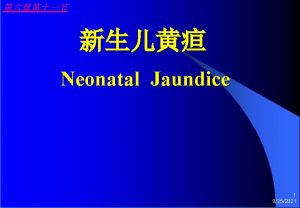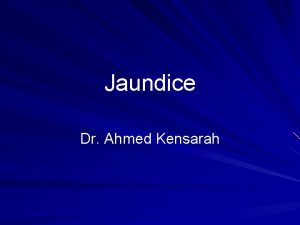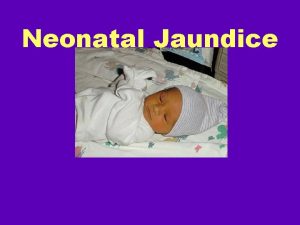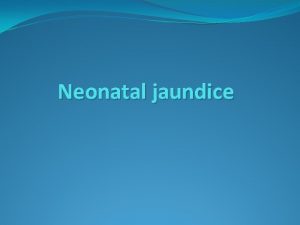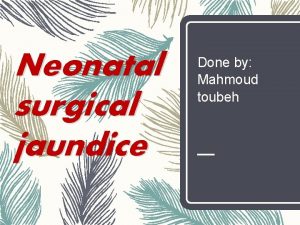JAUNDICES The icteric color of skin jaundice is












































































- Slides: 76

JAUNDICES

The icteric color of skin (jaundice) is a noticeable sign. It is observed at many infectious and noninfectious diseases. Very often groundlessly diagnosis of viral hepatitis is put at jaundice (30 -40% − by mistaken diagnosis). General sign for all jaundices is increase of level of bilirubin in the serum of blood. It can be caused by other reasons (acrichine, carotin), i. e. not by increased bilirubinemia.

At differential diagnostics of jaundices it is necessary: Decision of question about the presence of veritable jaundice, i. e. to eliminate other reasons of color of skin. To eliminate or confirm the jaundice related to aqute infectious pathology. To eliminate or confirm the jaundice related to aqute surgical pathology.



At hepatic insufficiency urobilinogen is not taken by hepatocytes and distinguished with urine, oxidizing on air to the urobilin. At viral hepatitis: 1) Mainly II phase is disturbed, i. e. activity of capture of free bilirubin goes down from the Disse's space (because of disfunction of hepatocyte), as a result the level of free bilirubin grows in blood. 2) IV phase is disturbed to because of conjugated bilirubin is excreted not in a bilious capillary and through the sinewave poles of hepatocytes in Disse’s space and then gets in blood. 3) Other stages are changed smaller and increase of general bilirubin is mainly due to direct bilirubin.

At a cholestatic variant: 1) an excretion and movement of bilirubin (IV phase) are considerably disturbed, 2) thrombuses appear in bilious capillars. 3) it results in conjugated bilirubin and other components of bile (bilious acids, cholesterol) enter Disse’s space and blood. 4) disturbance of passableness of bilious channels, for example, at biliary obstruction by a stone.

On pathogenesis hemolytic hepatic and subhepatic (cholestatic) jaundices are distinguished usually. Hemolytic jaundice is conditioned by increased disintegration of RBC and increased formation of bilirubin, insufficiency of capture by liver. Different types of hemolytic jaundice: 1) defects of RBC, 2) autoimmune hemolytic jaundices, 3) resorbable massive haematomas, 4) infarction.

Hepatic jaundices are conditioned by the injury of hepatocytes and, maybe, cholangiols. By leading mechanism it is possible to distinguish a few variants. 1) disturbance of excretion and capture of bilirubin, regurgitation of bilirubin (at a hepatocellular jaundice at sharp and chronic hepatitis, sharp and chronic hepatosis, hepatocirrhosis). 2) excretion of bilirubin is disturbed and regurgitation presents at cholestatic jaundice, cholestatic hepatitis, primary biliar hepatocirrhosis, idiopathic cholestasis. 3) disturbance of conjugation and capture of bilirubin can be at enzymopathic jaundice at the Gilbert's syndrome and other benign familial icteruses 4) disturbance of excretion of bilirubin can be at the Dubin-Johnson syndrome and Rotor syndrome.

Subhepatic jaundices arise up as a result of disturbance of passableness of bilious channels, a leading mechanism here is disturbance of excretion and regurgitation of bilirubin. By the character of biliary obstruction subhepatic jaundices is subdivided on: 1) intrachannelar (at biliary obstruction of bilious channels by stones, tumour, vorms, inflammatory exsudate, detritus of tissue), 2) extrachannelar (conditioned by the prelum of channels from outside by a tumour, Echinococcus, narrowing by scars. During realization differential diagnosticians of jaundices it is needed to define belonging of jaundice to that or another to the group, and then already to conduct differentiation into a group.

SUPRAHEPATIC JAUNDICE 1) It develops as a result of enhanceable products of bilirubin and insufficiency (relative) of function of its capture. 2) The increased disintegration of RBC (hemolysis) is basic in genesis, therefore usually it named hemolytic. 3) Main reason is out of liver − plenty of free bilirubin appears as a result of the increased disintegration of RBC that liver is unable to take (relative insufficiency), intracellular transport of pigment is disturbed probably too.

1) Because of the increased secretion of bilirubin in a bile maintenance of urobilin bodies increases in an excrement and urine. 2) Enhanceable maintenance of bilirubin in blood is conditioned by the accumulation of free (indirect) bilirubin. 3) At massive hemolysis hepatocytes not always are able to excrete all conjugated bilirubin, as a result maintenance of the conjugated bilirubin sometimes rises in blood. The level of jaundice at this form depends: from massiveness of hemolysisа, from functional state of liver (hepatocytes).

It is necessary to remember about possibility of combined genesis of jaundices at some infectious diseases (leptospirosis, sepsis). Hemolysis and damage of hepatocytes by causative agent or it’s toxins. Hemolysis can be druginduced (quinine, Sulfanilamidums) and damage of hepatocyte − by a causative agent (hemoglobinuric fever at a malaria). For the decision of question about suprahepatic character of jaundice the complex of clinical and laboratory data is used.

Main sign of suprahepatic jaundice − hyperbilirubinemia due to a free (indirect) bilirubin (bilirubinic coefficient − attitude of the conjugated bilirubin toward his general amount) not high (less than 50%). Important clinical signs: 1) absence of acholia; 2) presence of pleochromic bile and dark colouring of excrement and urine (increase of urobilinogen); 3) the jaundice of skin and sclera is moderate; 4) skin as a rule, pale (anaemia as a result of hemolysis); 5) liver and spleen can be enlarged, but the function of liver substantially is not broken (livers biopsy without considerable changes); 6) anaemia, increase of amount of reticulocytes (strengthening of regeneration of RBC) in peripheral blood, sometimes change of form of RBC (anisocytosis and other)

At diagnostic of suprahepatic (hemolytic) character of jaundice it is necessary to specify type. 3 types are distinguished. At a corpuscular hemolytic jaundice principal reason can be biochemical defects: 1)inherited enzymopathy RBC (deficiency of G 6 -PDG), 2)microspherocytosis, 3)hemoglobinopathys (thalassemia of and other), 4)defects of membranes of RBC (paroxysmal hemoglobinuria and other).

At extracorpuscular hemolyticой anaemia enhanceable hemolysis is conditioned by the action of different factors being in plasma of blood : 1)antibodies (for example, action of isoantibodies as a result of incompatible blood transfusion), 2)hemolysisines of different causative agents (viruses, Leptospira, causative agents of sepsis). 3)influence of disease causing (plasmodia of malaria) agent; 4)at the action of hemolytic poisons (arsenic, sulphuretted hydrogen of and other).

Third type − increase of products of bilirubin as a result of disintegration of RBC : 1) haematomas, 2) heart attacks, 3) hemorrhages in abdominal or pleural cavities. At anamnesis: third type of hemolytic jaundice : haematomas, hemorrhages (traumas, signs of the internal bleeding) clinical symptomatology of heart attacks of myocardium, lung.

At anamnesis: Corpuscular hemolytic jaundice often is repeated at persons with insufficiency of G 6 -PDG provoked by some drug (quinine, Sulfanilamidums NSAD) and accompanied by: ferver (hemoglobinuric fever), brown urine with large sediment, anemia. more often observed at patients with malaria.

Possibilities of differential diagnostics. Hereditary microspherocytosis: 1) related to the defect of membrane of RBC (enhanceable disintegration of RBC), 2) anaemia, 3) increase of spleen, 4) formation of stones is in a gall-bladder, 5) Нв decreases 40 -50 g/l 6) can be provoked by different infectious diseases, 7) amount of bilirubin rises up to 50 -75 mcmoll/l due to indirect bilirubin, 8) misdiagnosis of chronic hepatitis and even hepatocirrhosis is often put, 9) the diameter of RBC is diminished, and a thickness is enlarged, form is spherical, 10)amount of reticulocyteов is enhanceable, 11)diagnostics is difficult at combination with a cholestasis.

Hereditary stomacytosis (described in 1961 г) : 1) defect of membranes of RBC, 2) the form of RBC is original the unpainted part in their center is delimited by two bent lines and some reminds a mouth (from here the name of illness), 3) expressed anaemia (Нв 70 -90 g/l out of crysis and 30 -50 g/l during crysis), 4) increase of spleen, 5) jaundice due to an indirect bilirubin.

Jaundice at the hereditary hemolytic anaemia conditioned by the deficit of G 6 -PDG: 1) most widespread anomaly of RBC, 2) often conditioned by the reception of drugs during treatment of some infectious diseases, 3) most often meets in the countries of Africa, Latin America, on the coast of Mediterranean, in Azerbaijan (to 9, 9% population), rarer in other regions(2 -4%), 4) often provoked by Sulfanilamids, antimalarials (quinine, примахин, acrichine), nitrofurans, quinolons, derivatis of isonicotinic acid, paraaminosalicylic acid. 5) usually it appears on a 2 -3 th day from the start of treatment,

1) hemolytic crysis is usually named a hemoglobinuric fever. 2) in the start − moderate jaundice, dark urine, 3) on the 4 -5 th day heavy hemolytic crysis with brown urine, 4) the temperature rises, sharp headache appears, vomiting and diarrhoea are possible, jaundice grows, 5) Нв decreases to 20 -30 g/l 6) differentiating is necessary from other hemolytic jaundices.

Thalassemia: 1)it is contingented by the hereditary disturbance of synthesis of hematohistone, 2)jaundice, considerable increase of liver and spleen, 3)bilirubin in blood is enhanceable due to direct faction of pigment, 4)Where are reticulocytosis, anisocytosis, poykilocytosis, basophilic including in RBC at peripheral blood.

Autoimmune hemolytic anaemias: 1)idiopathic (reason is unknown), 2)symptomatic (develop at many illnesses: myelomatosis, lymphatic leukemia, lymphosarcoma, system red lupus, pseudorheumatism, ulcerous colitis). 3)can be provoked by many infectious diseases (measles, rubella, epidemic parotitis, quinsy, etc. ) when jaundice is not typical usually.

Autoimmune hemolytic anaemia with incomplete thermal agglutinins: 1)must be taken into account at idiopathic and symptomatic hemolytic jaundices, 2)start of illness is sharp or even stormy with growth of jaundice, 3)sharp weakness, pains in area of heart, shortness of breath, pains in back, palpitation, fever, 4)misdiagnosis of viral hepatitis is often put, 5)can begin gradually with pains in joints, stomach-ache, weakness,

6)subfebrile fever, pallor of the skin and moderate jaundice, 7)liver and spleen, as a rule, are enlarged, 8)bilirubin is enhanceable up to 40 -60 mcmoll/l due to indirect faction, 9)in blood the − amount of reticulocyteов is enhanceable, macrocytosis and/or microspherocytosis, fragmented destroyed RBC, 10)osmotic resistence of RBC is decreased. sometimes

paroxysmal night hemoglobinuria : 1)purchased form of the hemolytic anaemia related to the change of structure of RBC, 2)leucocytes and thrombocytes are damaged also, 3)the amount of uniform elements decreases, 4)gradual start, weakness, moderate jaundice, 5)headache, stomach-aches (thrombosis of mesenteric vessels sometimes is operated with suspicion on appendicitis or other surgical disease), 6)a liver and spleen are mildly enlarged,

7)the excretion of hemosiderin is characteristic at urine (dark color of urine in default of RBC in it), 8)proteinuria is expressed, 9)the benzidine test with urine is positive, 10)Нв in the period of intensifying decreased (30 -50 g/l), at the period of remission it is normal, 11)bilirubin in blood is mildly enhanceable due to indirect faction, 12)leucopenia 1, 5 -3 х 106/л. , 13)the level of iron in blood is decreased due to loses with urine.

During heavy lead-poisoning: 1)excretion with urine of hemosiderin in combination with stomach-aches and anaemia, 2)polyneuritis absent at night hemoglobinuria is characteristic. Other variants of suprahepatic jaundices are rarely.

HEPATIC JAUNDICES If patient really has a jaundice and the different variants of hemolyticой (suprahepatic) jaundice are excluded, the most difficult stage of differential diagnostics of jaundices differentiation of hepatic jaundices, because of the large number of infectious and uninfectious diseases have a hepatic jaundice:

viral hepatitis A, B, C, Д, Е, F, G; herpetic hepatitis; CMV hepatitis; yellow fever; infectious mononucleosis typhus recurrens intestinal yersiniosis; psittacosis; leptospirosis; pseudotuberculosis; salmonellosis; glanderss; sepsis; listeriosis; amoeba damage of liver; syphilis; toxic hepatitis: aqute alcoholic hepatitis; other hepatitises

For differential diagnostics of infectious and toxic hepatitis presence of signs of aqute infectious process (fever, signs of general intoxication, exanthema, epidemiology these and other) has a large value. For diagnostics of toxic hepatitis matter the use of hepatotoxic substances (antiphthisic preparations, inhibitors of МАО, derivatives of phenotiasin), technical liquids (dichlorethane, ethyleneglycol), occupational hazard (work with oxidants on the basis of nitric acid, hydrazone and other), and also absence of signs of infectious process.

For the decision of question about the presence of aqute viral hepatitis : 1) to compare fever and other signs of general intoxication with the degree of damage of liver. 2) At VHA and B fervescence and other signs of infectious toxicosis expressed unaqutely and mainly in the initial stages of illness. 3) At appearance and development of jaundice the temperature of body goes down, and the signs of general intoxication are expressed poorly (at VHA). 4) Differentiation of VHA and other causes difficulty, especially as their combination is possible. 5) VHA is possible more often at the persons of young age, sometimes − as epidemic infective episode, contacts with sick VHA presents in the terms laid in a latent period (more often 15 -30 days).

6) In age 25 -40 VHA durats heavier. 7) Duration of preicteric period at VHA is some shorter (up to 5 -7 days) than at VHB (more often 1 -4 weeks. ). 8) At VHA joint pains disturb rarer, more often flu-like syndrom, dyspepsia and asthenovegetative syndroms present at the pre-icteric period, at the end of pre-icteric period urine becomes dark and an excrement is discoloured. 9) The icteric period of HA begin with appearance of icteritiousness sclera, mucous membranes of pharynx, and then skin. Intensity of jaundice grows during a week. The temperature of body is normal, weakness, sleepiness, decline of appetite, pains in right hypochondrium, for some patients skin itch present. 10)A liver is enlarged, indurated and some painful, there is an increase of spleen at 20 -50% of patients. 11)There is leucopenia (sometimes normocytosis), neutropenia, relative lymphomonocytosis, ESR is a 2 -4 mm/h in peripheral blood. 12)Maintenance of general bilirubin is enhanceable mainly due to direct (conjugated).

13)Activity of transferases rises considerably, especially ALT, the indexes of thymol test are enlarged, a prothrombin index is decreased. An icteric period lasts 715 days. At most patients of VHA a bilirubinemia does not exceed 80 -90 mcmoll/l (5 mgs%). 14)A decubation is characterized by a fast disappearance of clinical and biochemical signs of hepatitis. 15)Biochemical indexes are usually normalized to the 2025 th day from the moment of appearance of jaundices. 16)The severe forms of VHA are observed rarely, chronic forms, as governed, does not develop.

Viral hepatitis B 1) It is transmitted by mainly parenteral way and latent period is more often 60 -120 days. 2) Pre-icteric period more long often with joint pains. More often dyspepsia and joint pains start at the pre-icteric period. 3) At 10% of patients short-term urticarial rash is marked. 4) At the end of pre-icteric period urine becomes dark, and an excrement is discoloured, the increase of liver is marked, activity of AST rises more than ALT. 5) Icteric period at VHB, as a rule, is prolonged and characterized by expressed and stable clinical signs. 6) An jaundice arrives at a maximum on a 2 -3 th week. 7) At severe forms already on the first days of jaundice aqute hepatic insufficiency (hepatic coma) can develop on a background of worsening of the state.

8) An jaundice grows gradually, the expressed, as a rule, is proportional to severity of illness (exceptions is possible). 9) The sizes of liver are enlarged. A spleen is often enlarged. 10)Reduction of sizes of liver at an increasing jaundice is an unfavorable sign. 11)Bradycardia and hypotension are characteristic. 12)The period of recovery is more protracted, than at VHA. 13)The dyspepsia and asthenic syndrome can save long time. 14)Recovery, prolonged and chronic forms of viral hepatitis are clinical outcomes. 15)At part of patients (about 0, 2%) hepatocirrhosis can develop in future. Laboratory discovery of Ag and/or Ab of VHB confirm diagnosis.

At the generalized forms of viral infection (herpetic, CMV), or septic bacillosiss appearance of jaundice takes place on a background a high fever and expressed symptoms of general intoxication (haemodynamic disorders, damage of the central nervous system and other) and different organ damages peculiar to one or another infectious disease, are not characteristic for VHA and VHВ.

Aqute herpetic hepatitis. 1) Usually durats latently, periodically (often on a background a flu and other illnesses) passes to the clinical form. 2) It is observed rarely and one of frequent signs of generalized, very severe herpetic infection. 3) Aqute suppression of immunity (reception of immunodepressants, cytostatics, prolonged reception of large doses of corticosteroids, radiologic therapy, AIDS and other) is preceded. The isolated herpetic hepatitis is impossible. 4) Damages of skin and mucous membranes are typical. 5) Different organ damages combine usually − herpetic encephalitis, viral -bacterial pneumonia and herpetic hepatitis. 6) The symptoms of general intoxication are aqutely expressed. 7) Illness durats severe, lethality about 30%.

Aqute CMV hepatitis. 1) CMV-INFECTION is widespread as a latent form. 2) For women CMV-INFECTION can stipulate the severe antenatal infection of fetus. Innate CMV-INFECTION is characterized by an jaundice, defects of development and often results in death of children. 3) Acquired CMV-INFECTION in a aqute period develops as an easy flu-like disease, and then passes to the latent form, at that CMV saved in an organism. 4) At the fall-off of immune defence a generalized form (patients by AIDS, on a background other the diseases − leukemia, cancer, severe surgical operations and other) can develop from latent. 5) Clinically − high fever, increase of liver and spleen, jaundice. 6) A liver is considerably enlarged, painful at palpation. 7) Practically always pneumonia viral etiology develops, antibiotic therapy is not effective. 8) An encephalitis develops often. 9) There are not a herpetic exanthema at CMV-INFECTION.

Innate CMV-INFECTION at new-born 1) Always develops with the signs of aqute hepatitis, hemorragic syndrome, encephalitis. 2) An jaundice grows 2 -3 weeks and in 2 -6 months goes down 3) Activity of transferases and ALKALINE PHOSPHATASE is enhanceable. 4) There can be defects of development, innate damages of eyes (cataract, chorioretinitis, atrophy of visual nerve). 5) The number of thrombocytes is considerably decreased, anaemia develops. 6) For confirmation of diagnosis of CMV-INFECTION − cytological research of of saliva, urine, CSF : finding out the cytomegalic cells.

Icteric form of infectious mononucleosis. 1) Aqute hepatitis caused by a virus Epstein-Barr does not behave to viral hepatitises. 2) Jaundice of hepatic genesis, increase of liver, increase of activity of serum enzymes — ALT, AST, ALKALINE PHOSPHATASE and other present. 3) Expressed syndrome of general intoxication (fervescence up to 3940 °C, general weakness, headache and other), saves and sometimes grows after appearance of jaundice. 4) The basic signs of infectious mononucleosis for differential diagnostics are following: а) fever; б) tonsillitis; с) generalized lymphadenopathy; д) increase of liver and spleen; е) characteristic changes of peripheral blood. 5) A diagnosis is confirmed by ELISA and/or PCR.

Yellow fever. 1)Quarantine endemic illness of the countries of South America and equatorial Africa. 2)If more than 6 days passed from leaving a endemic country it allows to eliminate a yellow fever. 3)Clinically illness starts suddenly with a fervescence to 39 -40 °C. 4)There are hyperemia and puffiness of face, edema of eyelids, injection of vessels of conjunctiva of sclera, tachycardia (to 130 in a minute) from the first day.

5)Nausea and vomiting, hyperemia of mucous membrane of oral cavity appear on a 2 th day, on the 3 -4 th day − jaundice. 6)There is a very short remission on the 5 th day of illness, later the temperature increases again and hemorragic syndrome appears. 7)Tachycardia is replaced by bradycardia (40 -50 in a minute), BP decreases. 8)Death comes from aqute kidney insufficiency or from infectious-toxic shock. 9)At a favourable end from a 7 -9 th day the state begins to get better. 10)A diagnosis is confirmed by specific laboratory data.

At all bacterial hepatitis the same signs at other hepatitis are marked: increase of liver (quite often spleens), considerable increase of level of bilirubin, hepatic character of jaundice, substantial increase of activity of serum enzymes (ALT, AST). Differences from viral hepatitis A and B are aqutely expressed infectious syndrome and damage of different organs and systems.

Leptospirosis. 1)Often an icteric form develops severe. 2)Epidemiology pre-conditions (summer seasonality, bathing in freshwater reservoirs, contacts with animals). 3)Start of disease is aqute and even sudden. 4)The temperature rises with a chill, as a rule, higher 39 °С. 5)There are hyperemia of face and neck, injection of vessels of sclera from the first days of illness. 6)Jaundice appears from a 3 -5 th day from the start of disease. 7)A liver and spleen are enlarged from the first days of illness.

8)A pathognomonic sign is damage of muscles (especially sural). 9)The second obligatory symptom is a damage of kidneys (oligoanuria). 10)Amount of bilirubin in blood can arrive to 200 -300 mcmoll/l and more, activity of AST and ALT rises. 11)Joining of hemorragic syndrome, serous meningitis, twowave character of temperature curve are typical. 12)Where are neutrophilic leucocytosis (15 х 109/л), early and considerable increase of ESR in CBC. 13)For confirmation of diagnosis specific methods are used.

Pseudotuberculosis. 1)The icteric forms of pseudotuberculosis meet often. 2)An jaundice develops at moderate and severe forms with the expressed clinical symptoms. 3)Jaundice, increase of liver, the laboratory signs of hepatitis differ nothing from other jaundices of infectious nature. 4)Start is aqute, body temperature 38 -40 °С. 5)The injection of vessels of sclera, hyperaemia of face, neck, upper departments of trunk ( «symptom of hood» ) appear early.

6) Punctulated ( «scarlatiniform» ) exanthema more often on the 3 th day of illness is abundant and placed on all body with a concentration in area of natural folds of skin (ulnar bends, inguinal areas of and other) is characteristical. 7) Skin of hands and soles is hyperaemic, tongue bright red with enlarged papillae, without a coat ( «raspberry tongue» ). 8) Sometimes the icteric forms of pseudotuberculosis develops without a rash. 9) Mesadenitis and terminal ileitis manifest by spontaneous pains in a right iliac area, expressed sickliness of this area at palpation. 10)Sometimes repeated waves of fever, damage of joints, knotted erythema take place. 11)Laboratory confirmation is serological.

Intestinal yersiniosis. 1)Similar with pseudotuberculosis, but an jaundice is marked, as a rule, only at the very severe septic forms of intestinal yersiniosis. 2)Basic clinical signs are high fever, repeated chills and sweats, anemia, expressed jaundice, increase of liver and spleen. 3)Stomach-aches more often on the right lower parts is typical, diarrea is possible. 4)Part of patients has secondary purulent processes, purulent arthritises. 5)Laboratory confirmation is serological.

Salmonellosis. 1) Jaundice appears only at the severe forms of salmonellosis (generalized). 2) High fever (39 -40°С), expressed intoxication, increase of liver and spleen, signs of hepatic jaundice. 3) Damage of GIT in an initial period (gastroenteritis) is typical. 4) Illness develops as typhoid or sepsis. 5) Confirmed bacteriologically and serologically.

Listeriosis. 1) Jaundice at some forms (anginal-septic and typhoid). 2) High fever, intoxication. 3) Generalized lymphadenopathy, sometimes specific mesadenitis. 4) A damage of pharynx manifests by tonsillitis quite often with necrotizing changes. 5) In these cases it is difficult to differentiate from the icteric forms of infectious mononucleosis. 6) At part of patients macular or erithematous rash on face in figure of butterfly. 7) Sometimes − signs of purulent meningitis. 8) A diagnosis is confirmed by finding of causative agent (from blood, CSF, pharynx) and serologically.

Sepsis. 1) It is polyetiologic disease. 2) Presence of primary suppurative focus. 3) Severe acyclic development without a tendency to spontaneous recovery. 4) Clinically: intoxication, fever, damage of liver, anemia, polyorganic insufficiency. 5) An jaundice is expressed mildly and does not correspond to severity of process. 6) Quite often - shock, hemorragic syndrome with the signs of DIC. 7) Confirmed by the finding of causative agent from blood and suppurative focuss. 8) Serological methods are low-informative.

Glanderss. 1)Meets very rarely. 2)Develops as an original sepsis. 3)Liver, skin, hypoderm, joints and muscles are often damaged. 4)Laboratory confirmation the finding of causative agent from blood or from abscesses.

Relapsing fever. 1) Now this illness is not present in our country. 2) A disease begins paroxysmaly in the first half day. 3) The temperature of body with a staggering chill (as at a malaria) rises to 39 °C and higher, but does not go down in next days and some increases even. Pains in muscles, nausea, vomiting. 4) Rapid and considerable increase of spleen, spontaneous pains in left hypochondrium and expressed sickliness at palpation of spleen. 5) Sometimes − ruptureof spleen or hemorragic syndrome. 6) In 4 -6 days the temperature of body falls critically, and the repeated (more short) attack of fever is possible in 6 -9 days. 7) An antibiotic therapy prevents the repeated attacks. 8) Epidemiological data − pediculosis, contact with a patient. 9) The microscopy of thick drop of blood − spirochete.

Psittacosis. 1)An jaundice is marked rarely (0, 3 -0, 5%). 2)An jaundice is marked together with ordinary (pneumonic) development of psittacosis. 3)Prolonged asthenic syndrome is characteristic. 4)Use of penicillin, streptomycin and Sulfanilamids is uneffective. 5)In CBC − leucopenia, neutropenia, enhanceable ESR. 6)Specific confirmation – serological (CFR − 1: 16 and higher).

Babesiasis. 1)Acute severe protozoan disease with an jaundice and aqute kidney insufficiency. 2)Mainly at immunodeficiency. 3)In the countries of Europe and USA. 4)Owners of parasite are animals (rodents, dogs, cattle), carrying agent is a pascual tick. 5)Reason of death of patients usually is uremic coma.

Amebiasis. 1) As a result of amoeba hepatitis (in the aqute period of illness). 2) As the sign of amoeba abscess of liver. 3) In a aqute period the expressed disfunctions of bowel (stool with the admixture of mucus and blood, ulcerous changes of colon from data of RRS) normal or subfebrile temperature and slight signs of general intoxication present. 4) Prolonged develop of illness with engaging in the process of all departments of colon. 5) A diagnosis is confirmed by discovery in feces (or in the material taken from intestinal ulcers at RRS) tissue forms of dysenteric amoeba. 6) There is a moderate jaundice at the amoeba abscess of liver. 7) USI, anamnesis have diagnostic value, in this period dysenteric amoebae in defecating already is not revealed.

Toxic hepatitis − there are not signs of infectious process (fever, other signs of general intoxication) and presence of the phenomena peculiar to poisoning. Aqute alcoholic hepatitis 1)At men suffering chronic alcoholism or after the reception of different substitutes of alcohol. 2)Often − leucocytosis, increase of activity of alkaline phosphatase, higher maintenance in blood of cholesterol. 3)Bilirubinic- transferases dissociation (the degree of increase of ALT some falls behind from the level of hyperbilirubinemia).

Medicamental hepatitis 1)Conditioned by many drugs. 2)Often at the reception of drug long time and in large doses. More than half of cases − application of antiphthisic drugs. Except an jaundice and increase livers can be other signs of medicinal illness: dyspepsia disorders, allergic disturbances. 3)The cyclicity of development of disease is absent. 4)The indexes of thymol test are negative. 5)Morphologically − picture of aqute infiltration hepatitis, and at VH aqute destructive hepatitis is typical.

Toxic hepatitis at poisoning pesticide 1)The symptoms of hepatitis appear on the 2 -3 th day of poisoning. 2)Clinically (depending on the type of poison) for differential diagnostics a basic value are: a) information about a contact or use of poisons or technical liquid; b)symptomatology of initial period of «drunkenness» ; c) the period of brief improvement is possible; d)combination of signs of toxic hepatitis with a damage GIT, CNS, kidneys.

Prolonged jaundices (during many months and years in the stage of intensifying or remission): chronic hepatitis (including - autoimmune), hepatocirrhosiss, pigmental hepatosises. The time factor allows to exclude all aqute hepatitises (infectious and toxic), hemolyticе jaundices.

Chronic hepatitises in the stage of relapse (exacerbation) : 1)weakness, indisposition, pains in area of liver and in an epigastrium, skin itch, vascular «stars» on a skin, dyspeptic syndrome; 2)increase of liver and spleen; 3)an increase of bilirubin , activity of ALT, AST, gamma globulin, the amount of albumens decreases; 4)quite often antigens of viruses of hepatitis B, C, D of and other are revealed; 5)in the period of remission jaundice can be absent, but liver is enlarged; 6)development prolonged, relatively favourable.

Autoimmune hepatitis: 1) is often observed at women in age 15 -25 and 45 -55; 2) disturbance of menstrual cycle, hirsutism, rash and progressing jaundice are characteristic. 3) passes to the hepatocirrhosis. Chronic cholestatic hepatitis: 1) more often at the elderly and senile age; 2) expressed jaundice, but the poorly expressed intoxication; 3) ends usually by biliar hepatocirrhosis; 4) in the period of exacerbation a clinic is similar with a mechanical jaundice; 5) AST, ALT , thymol tests are normal or insignificantly changed. 6) general cholesterol, ALKALINE PHOSPHATASE, bilirubin (mainly due to direct faction) are increased.

Hepatocirrhosis: 1) chronic hepatitises B, C, D have leading role; 2) usially liver is dense and not enlarged and sometimes diminished; 3) signs of portal hypertension (bleeding); 4) spleen is considerably enlarged, ascites; 5) physical working capacity is decreased, general weakness, dyspepsia, flatulence; 6) vascular «stars» , palm's erythema, increased venous picture on a stomach, palpebrarum, fingers as «drumsticks» ; 7) urine is dark, feces is pale; 8) change of proteins of plasma (decline of albumens and increase of globulins); 9) activity of serum enzymes (AST, ALKALINE PHOSPHATASE) is mildly enhanceable.

Gilbert's Syndrome (hereditary pigmental hepatosis) : 1)starts in young or juvenile age and expressed in the chronic, periodically appearing mildly expressed jaundice; 2)conditioned by the increase of free bilirubin, in default of complex of signs of hemolytic jaundices (change of mechanical and osmotic resistance of RBC, their morphology, considerable increase of liver and spleen and other). Crigler-Najjar syndrome is similar with the �Gilbert's Syndrome, but appears from the period of new-bornness, maintenance only of free bilirubin rises.

Dubin-Jhonsson Syndrome: 1) observed in juvenile and young age; 2) hyperbilirubinemia due to mainly conjugated or in an equal degree free and conjugated factions of pigment; 3) bilirubinuria; 4) at cholecystography bilious ways are not filled or filled poorly; 5) morphologically − in tissue of liver accumulation of characteristic dark pigment ( «black liver» ). Rotor syndrome: 1) more often in child's age; 2) mainly conjugated bilirubin accumulates in blood; 3) bilirubinuria; 4) morphologically - no pathology of liver; 5) cholecystography − bilious ways are not filled after intravenous introduction of contrasting substance.

SUBHEPATIC JAUNDICES Conditioned by disturbance of leadingout of bilirubin through bilious channels with the regurgitation of it, and also decline of excretion of bilirubin from hepatocytes. A pathological process is localized out of liver in the main bilious channels − mechanical jaundices.

Subhepatic jaundices can be conditioned by many factors: 1)closing (obstruction) hepatic and general bilious channels from within by gall-stones, helmints of and other; 2)by the compression of general bilious channel outside (tumor, enlarged lymphatic nodes); 3)stenosis of general bilious channel by scars and jointins (after operative intervention, inflammatory process); 4)atresia (hypoplasia) of bilious ways.

At subhepatic jaundices: 1) Maintenance of the conjugated (direct) bilirubin rises mainly. 2) After the obstruction of bilious channels the excretion of bile from hepatocytes proceeds somet time. 3) The increase of pressure in bilious channels results in the secondary changes of hepatocytes, as a result the excretory function of hepatic cells goes down and paracholia comes, i. e. intrahepatic cholestasis. The increase of level of indirect (free) bilirubin, presumably, is related to disturbance of capture by hepatocytes from blood. 4) The excretion of urobilinic bodies with feces and urine at mechanical jaundices is absent.

Differential diagnostics has a most practical value with: 1) cholestatic variant of viral hepatitis, 2) mechanical jaundice as a result of compression of bilious channels by tumor, 3) mechanical jaundice at biliary obstruction by stones or helmints. Cholestatic variant of viral hepatitis : 1) mainly at VHB, but possible and at hepatitis C and other. . 2) markers of viral hepatitis , recurrence of development, anamnesis. 3) observed for the people of any age. 4) pains are expressed mildly, localized in right hypochondrium, sometimes in epigastric area.

Tumor and cholelithiasis : 1) More often marked older 40 y. o. 2) Women have a calculous cholecystitis mainly. 3) Disturbance of diet is sometimes preceded appearance of obstruction jaundice. 4) There are signs of cholecystitis (pains in area of liver, jaundice and other) in anamnesis. 5) At tumor obstruction of bilious channels can be preceded chronic diseases of stomach, pancreas, loss of body mass, anemia and other - signs characteristic for tumor. 6) At obstruction of bilious channels by the stone pain attack after that an jaundice appears soon. 7) Pains have a characteristic irradiation in a right shoulder, shoulder-blade. 8) During a pain attack there can be nausea, vomiting, sometimes diarrea. 9) At tumor, pain can be very strong, but she develops gradually and progreses.

10)At all these states next also can be observed: Intensive jaundice and itch of skin. Hemorragic syndrome. 11)A fever at VHB is short-time and observed to development of jaundice. 12)At tumor at the start a temperature of body can be subfebrile (and even normal), but at progress of process disintegration of tumour tissue the temperature of body grows (often has large daily fluctuation). 13)At a calculose cholecystitis the temperature of body is also enhanceable, sometimes accepts septic character (fever of wrong type). 14)An anacholia is observed at all these illnesses. 15)Increase of liver of is observed at all examined illnesses. 16)At the mechanical jaundice conditioned by obstruction of bile ducts by a tumour or stone gall-bladder increases (symptom of Courvoisier’s). 17)gall-bladder is palpated as the large, tense painful rounded formation during obstruction of general bilious channel by the tumour of head of pancreas or tumour in area of papilla of duodenum. 18)Glucocorticoids reduce expressed jaundice at VHB, but not at the mechanical jaundices.

19)In blood for the patients of viral hepatitis leucopenia, ESR normal, but at the subhepatic jaundices caused by a tumour or stones more often leucocytosis and increase of ESR are found. 20)At the cholestatic variant of viral hepatitis activity of transferases is substantially enhanceable, moderate increase of ALKALINE PHOSPHATASE, thymol test positive, a cholesterol is decreased. 21)At tumor activity of transaminases is normal, ALKALINE PHOSPHATASE and cholesterol are aqutely enhanceable. 22)At biliary obstruction by a stone activity of ALKALINE PHOSPHATASE rises substantially, and sometimes activity of transferases rises short-timely, thymol test - negative, the cholesterol is mildly enhanceable or in a norm. 23)At viral hepatitis positive reaction on an urobilin is positive, while at the jaundices a reaction on an urobilin is negative. 24)Additional researches have an important value: USI. СT, X-ray, FGDS, laparoscopy.

Mechanical jaundice conditioned by helmints (opisthorchiasis, clonorchosis, schistosomiasis) : 1)jaundice is moderate or slight, 2)the expressed pain attacks are absent, 3)epidemiology data (endemic for these helminths districts), 4)eosinophilia(15 -20% and more), 5)confirmed by finding out of helminths or its ova, 6)specific allergic and immunological reactions.

The End
 Icteric color
Icteric color Obstructive jaundice lab diagnosis
Obstructive jaundice lab diagnosis Icteric sample
Icteric sample Icter hepatocelular
Icter hepatocelular Examen coproparazitologic prin centrifugare
Examen coproparazitologic prin centrifugare Icteric
Icteric Thick or thin skin
Thick or thin skin Thin skin vs thick skin
Thin skin vs thick skin Milady chapter 23 pdf
Milady chapter 23 pdf Biology of skin color video questions
Biology of skin color video questions Skin color map of the world
Skin color map of the world Human skin color wheel
Human skin color wheel Regardless of skin color
Regardless of skin color Vitamin a skin color
Vitamin a skin color Inspect uniformity of skin color rationale
Inspect uniformity of skin color rationale Bronze color skin disease
Bronze color skin disease Types of jaundice
Types of jaundice Grafik hiperbilirubinemia
Grafik hiperbilirubinemia Bilirubin metabolism summary
Bilirubin metabolism summary Icterus grading
Icterus grading Types of jaundice
Types of jaundice Palmar erythema causes
Palmar erythema causes Olive green jaundice
Olive green jaundice Courvoisier's law
Courvoisier's law Jaundice
Jaundice Intrahepatic jaundice
Intrahepatic jaundice Jaundice differential diagnosis
Jaundice differential diagnosis Glisson üçgeni
Glisson üçgeni Elevated direct bilirubin causes
Elevated direct bilirubin causes Dermal zones of jaundice
Dermal zones of jaundice Hepatocellular jaundice
Hepatocellular jaundice Neonatal jaundice
Neonatal jaundice Acholia causes
Acholia causes Jaundice classification
Jaundice classification Normal range alkaline phosphatase in child
Normal range alkaline phosphatase in child Jaundice case presentation
Jaundice case presentation Jaundice pathogenesis
Jaundice pathogenesis Prehepatic jaundice
Prehepatic jaundice Bhutani nomogram
Bhutani nomogram Post hepatic jaundice
Post hepatic jaundice Breast milk jaundice slideshare
Breast milk jaundice slideshare When can a food handler with jaundice return to work
When can a food handler with jaundice return to work Discriminant factor formula
Discriminant factor formula Bilirubin pathway
Bilirubin pathway Pathologic jaundice
Pathologic jaundice Types of jaundice
Types of jaundice Jaundice classification
Jaundice classification Causes of icterus
Causes of icterus Portal vein thrombosis jaundice
Portal vein thrombosis jaundice Choluric vs acholuric jaundice
Choluric vs acholuric jaundice Pathologic jaundice
Pathologic jaundice Jaundice
Jaundice Gas-filled bowel loops in abdomen meaning
Gas-filled bowel loops in abdomen meaning Phototherapy unit uses
Phototherapy unit uses Jaundice under tongue
Jaundice under tongue Post hepatic jaundice
Post hepatic jaundice Prehepatic jaundice
Prehepatic jaundice Silent icterus
Silent icterus Hyperbilirubinemia workup
Hyperbilirubinemia workup Jaundice definition
Jaundice definition Clinical manifestation of hepatitis
Clinical manifestation of hepatitis đặc điểm cơ thể của người tối cổ
đặc điểm cơ thể của người tối cổ Các châu lục và đại dương trên thế giới
Các châu lục và đại dương trên thế giới Mật thư anh em như thể tay chân
Mật thư anh em như thể tay chân Tư thế worm breton là gì
Tư thế worm breton là gì ưu thế lai là gì
ưu thế lai là gì Thẻ vin
Thẻ vin Tư thế ngồi viết
Tư thế ngồi viết Cái miệng xinh xinh thế chỉ nói điều hay thôi
Cái miệng xinh xinh thế chỉ nói điều hay thôi Các châu lục và đại dương trên thế giới
Các châu lục và đại dương trên thế giới Bổ thể
Bổ thể Từ ngữ thể hiện lòng nhân hậu
Từ ngữ thể hiện lòng nhân hậu Tư thế ngồi viết
Tư thế ngồi viết Ví dụ về giọng cùng tên
Ví dụ về giọng cùng tên Thể thơ truyền thống
Thể thơ truyền thống 101012 bằng
101012 bằng Chúa yêu trần thế
Chúa yêu trần thế
